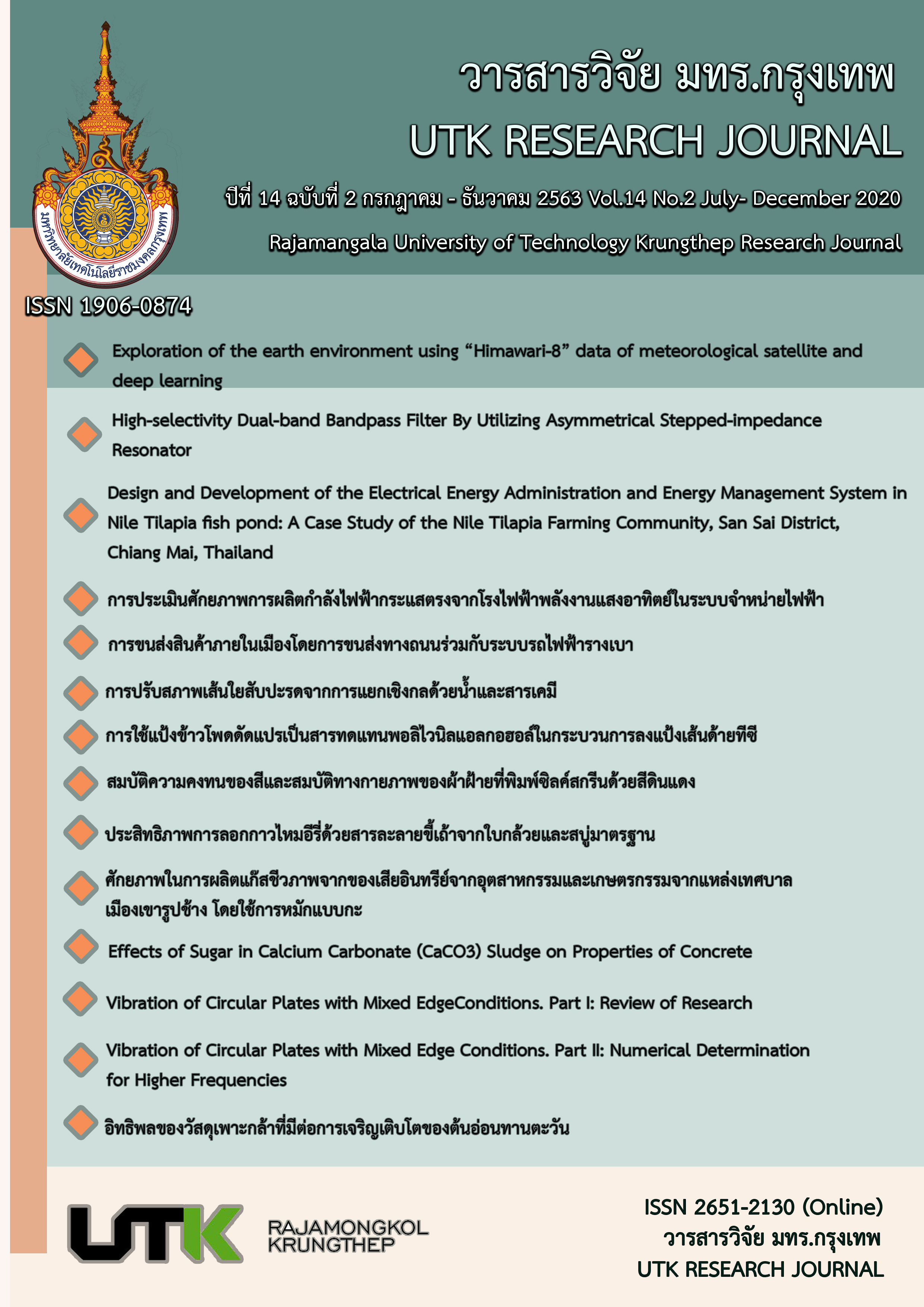Exploration of the earth environment using “Himawari-8” data of meteorological satellite and deep learning
คำสำคัญ:
Himawari-8, 16-wavelengths, Artificial Intelligence, Deep Learning, Supervised Learningบทคัดย่อ
In the field of satellite remote sensing, artificial intelligence (AI) is the method frequently used to explore the global environment in many researches. Deep learning is widely used to analyze the satellite images. The detection or tracking on typhoons, clouds, land and snow are examples of research on the earth’s environment with deep learning. The conventional method, RGB and IR images of the satellites, are used as the inputs of deep learning using convolution operations such as convolution neural network (CNN). We have developed the method to investigate the earth’s environment and its variations. The method is based on the supervised learning model of artificial intelligence with 16 wavelength spectral image data (from visible to infrared range) obtained by the geostationary meteorological satellite "Himawari-8". The input layer was given information of 16 wavelengths instead of an image, not convolution operation. The output from the proposed algorithm is classification of 6 classes such as typhoon, cloud, sea, land, snow and ice. We also succeeded in visualizing that typhoons and developed clouds contain snow and ice. The combination of spectrum data acquired by satellites and our proposed method is effective for forecasting typhoons, and drift ice, torrential rain and so on. By providing spectral data of the meteorological satellite “Himawari-8” to the input layer of the proposed method, our model can recognize the earth environment in all space and time (365 days, 24 hours). The model developed this time has reached the accuracy of 96.5%. It will be an effective method for drawing out the capabilities of artificial satellites in the environment exploration of the earth and planets.
เอกสารอ้างอิง
Yang X, Zhan Z, Shen J. A Deep Learning Based Method for Typhoon Recognition and Typhoon Center Location. 2019 IEEE International Geoscience and Remote Sensing Symposium. 2019 July 28 – Aug 2. Yokohama, Japan. Japan: IEEE; 2019.
Zhou B, Khosla A, Lapedriza A, Aude Oliva and Autonio Torralba, Learning Deep Features for Discriminative Localization. 2016 IEEE Conference on Computer Vision and Pattern Recognition (CVPR). 2016 June 27-30. Las Vegas, USA. USA: IEEE; 2016.
Yang J, Guo J, Yue H, et al. 2019. CDnet: CNN-Based Cloud Detection for Remote Sensing Imagery. IEEE Trans Geosci Rem Sens. 2019; 57(8): 6195 – 211.
Dronner J, Korfhage N, Egli S, et al. Fast Cloud Segmentation Using Convolutional Neural Networks [Internet]. Remote Sens. 2018; 10(11): https://doi.org/10.3390/rs10111782
Zhan Y, Wang J, Shi J, et al. Distinguishing Cloud and Snow in Satellite Images via Deep Convolutional Network. Geosci Rem Sens Lett IEEE, 2017; 14(10): 1785-9.
Zhang C, Wei S, Ji S, et al. Detecting Large-Scale Urban Land Cover Changes from Very High Resolution Remote Sensing Images Using CNN-Based Classification [Internet]. ISPRS International Journal of Geo-Information. 2019; 8(4): https://doi.org/10.3390/ijgi8040189
Zhang J, Liu P, Zhang F, et al. CloudNet: Ground-Based Cloud Classification with Deep Convolutional Neural Network. Geophys Res Lett. 2018; 45:1-8.
Qian Liu, Yun Li, Manzhu Yu, et al. Daytime Rainy Cloud Detection and Convective Precipitation Delineation Based on a Deep Neural Network Method Using GOES-16 ABI Images. Remote Sens. 2019; 11(21):2555.
Bessho K, Date K, Hayashi M, et al. An introduction to Himawari-8/9 – Japan’s new-generation geostationary meteorological satellites. J Meteorol Soc Jpn. 2016; 94(2):151-83.
Murata KT, Pavarangkoon P, Higuchi A, et al. A web-based real-time and full-resolution data visualization for Himawari-8 satellite sensed images. Earth Sci Inform. 2018; 11:217-37.
Ioffe S, Szegedy C. Batch Normalization: Accelerating Deep Network Training by Reducing Internal Covariate Shift. ICML’15: Proceedings of the 32nd International Conference on Machine Learning PMLR. 2015 July 6-11. Lille, France. 2015; 37: 448-56.
Meteorological Satellite Center JMA [Internet]. Japan; 2015 [cited 2020 May 28]. Available from: https://www.jma.go.jp/jma/jma-eng/ satellite/VLab/Outline_RGB_composite.pdf
Meteorological Satellite Center JMA [Internet]. Japan; 2015 [cited 2020 May 28]. Available from: https://www.jma.go.jp/jma/jma-eng/satellite/VLab/RGB-Day_Snow-Fog.pdf
ดาวน์โหลด
เผยแพร่แล้ว
รูปแบบการอ้างอิง
ฉบับ
ประเภทบทความ
สัญญาอนุญาต
กองบรรณาธิการวารสารวิชาการ มหาวิทยาลัยเทคโนโลยีราชมงคลกรุงเทพ มีความยินดีที่จะรับบทความจากอาจารย์ นักวิจัย นักวิชาการทั้งภายในและภายนอกมหาวิทยาลัย ในสาขาวิชาวิทยาศาสตร์และเทคโนโลยี ได้แก่ สาขาวิชาวิทยาศาสตร์ วิศวกรรมศาสตร์ และสาขาอื่นๆ ที่เกี่ยวข้อง รวมถึงสาขาต่างๆ ที่มีการบูรณาการข้ามศาสตร์ที่เกี่ยวข้องวิทยาศาสตร์และเทคโนโลยี ที่เขียนเป็นภาษาไทยหรือภาษาอังกฤษ ซึ่งผลงานวิชาการที่ส่งมาขอตีพิมพ์ต้องไม่เคยเผยแพร่ในสิ่งพิมพ์อื่นใดมาก่อน และต้องไม่อยู่ในระหว่างการพิจารณาของวารสารอื่น
การละเมิดลิขสิทธิ์ถือเป็นความรับผิดชอบของผู้ส่งบทความโดยตรง บทความที่ได้รับการตีพิมพ์ต้องผ่านการพิจารณากลั่นกรองคุณภาพจากผู้ทรงคุณวุฒิและได้รับความเห็นชอบจากกองบรรณาธิการ
ข้อความที่ปรากฏอยู่ในแต่ละบทความที่ตีพิมพ์ในวารสารวิชาการเล่มนี้ เป็นความคิดเห็นส่วนตัวของผู้เขียนแต่ละท่าน ไม่เกี่ยวข้องกับมหาวิทยาลัยเทคโนโลยีราชมงคลกรุงเทพแต่อย่างใด ความรับผิดชอบด้านเนื้อหาและการตรวจร่างบทความแต่ละบทความเป็นของผู้เขียนแต่ละท่าน หากมีความผิดพลาดใดๆ ผู้เขียนแต่ละท่านจะต้องรับผิดชอบบทความของตนเองแต่ผู้เดียว
กองบรรณาธิการขอสงวนสิทธิ์มิให้นำเนื้อหา หรือข้อคิดเห็นใดๆ ของบทความในวารสารวิชาการ มหาวิทยาลัยเทคโนโลยีราชมงคลกรุงเทพ ไปเผยแพร่ก่อนได้รับอนุญาตจากกองบรรณาธิการ อย่างเป็นลายลักษณ์อักษร ผลงานที่ได้รับการตีพิมพ์ถือเป็นลิขสิทธิ์ของวารสาร






